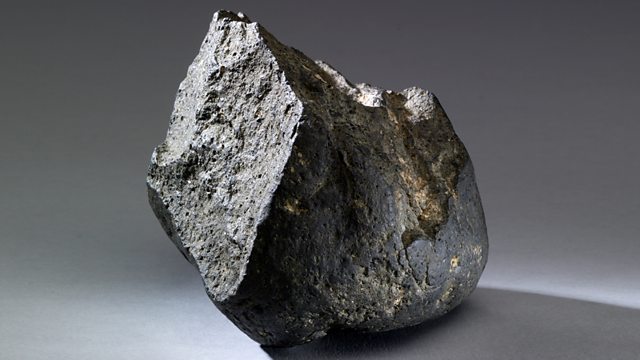Olduvai Stone Chopping Tool
Director of the British Museum, Neil MacGregor, retells humanity's history through the objects it has made. Today he encounters the very first tool made by our ancestors
The Director of the British Museum, Neil MacGregor, retells the history of human development from the first stone axe to the credit card, using 100 selected objects from the Museum. In this programme, Neil goes back two million years to the Rift Valley in Tanzania, where a simple chipped stone marks the emergence of modern humans.
One of the characteristics that mark humans out from other animals is their desire for, and dependency on, the things they fashion with their own hands. This obsession has long roots and, in today's programme, Neil introduces one of the earliest examples of human ingenuity. Faced with the needs to cut meat from carcasses, early humans in Africa discovered how to shape stones into cutting tools. From that one innovation, a whole history human development springs.
Neil MacGregor tells the story of the Olduvai stone chopping tool, with contributions from Sir David Attenborough and African Nobel Prize winner Dr Wangari Maathai
Last on
![]()
Discover more science & technology programmes within A History of the World in 100 Objects
About this object
Location: Olduvai Gorge, Tanzania
Culture: Early People
Period: 1.8 - 2 million years old
Material: Stone
This chopping tool is the oldest humanly made object in the British Museum. It could be used for many purposes including chopping bones, plants and wood. By using a stone hammer to knock flakes off of a pebble our ancestors could make a tool with a sharp, functional edge. Olduvai is part of the great East African Rift Valley torn open by massive earthquakes. Many skulls and bones of our early ancestors have been found along this valley.
Can we be human without objects?
The invention of the first tools is one of the most important moments in human history. Making, using and sharing things played a key role in developing human behaviour. The ability to make tools allowed humans to adapt to new environments and out-compete other animals. Gradually it would lead to humans becoming the most successful animal in the world. All modern technology began with these first chopping tools
Did you know?
- The discovery of this stone tool helped to prove that humans evolved in Africa
Touching history
By Kusuma Barnett, Head of Volunteers, British Museum
When you look at this object you might ask yourself what is it and why is it in the Museum? If you were able to hold it in your hand as I did in 2005 and find how comfortably it fits into your palm (like a computer mouse!), you would know straight away that this was made to be held by a person.
I never thought I would have the opportunity to handle something made nearly 2 million years ago. It was just like touching history.
I was one of a team of volunteers which helped visitors to the Museum handle this object. Most of our visitors were just as excited as I was at being able to hold something that was so old.
Some visitors were close to tears. Some were sceptical: was it really made by man and not a piece of rock? I was able to show the visitors the sharp and uniform cutting edge and discuss with them the possibility of how it could have been made by deliberately knocking flakes off the sides using a hard stone a bit like a hammer.
In a letter written to the Museum, a visitor said: ‘The opportunity to hold one of the oldest human artefacts was a unique feeling, and I can honestly say that I have rarely found an object fit so neatly into my hand’. It was the same for many of our visitors who handled the chopping tool.
It is one of the most memorable experiences of my time at the Museum.
Is it objects that make us human?
By Professor Clive Gamble, Archaeologist, Royal Holloway University of London
This stone tells two stories: one about the fossil ancestor who made the tool and the other about the fossil hunter who found it. Is it having objects that makes us human?
The ancestor and the archaeologist are separated by almost two million years. They are similar because both walked upright and used tools. However, they differ greatly in the size of their brains and the sophistication of their technology. So are they both human?
Louis Leakey, the flamboyant Kenyan-born fossil hunter and champion of the importance of Africa for human evolution, was 28 when he found this stone tool. Not everyone believed that they were ancient artefacts and he had to wait another thirty years before it could be scientifically proven.
At the time, he claimed that these ancient Olduvai people, for whom 28 was a ripe old age, were our ancestors because they had things, like this tool. But crows, sea otters, monkeys and apes all make and use tools and we don’t call them human. In fact, these ancestors had brains not much larger than a chimpanzee – almost three times smaller than our own. So, if it wasn’t big brains that made us tool users or tools alone that made us human, was it our minds and imagination?
But how can a stone tool help us to understand the extent of the human mind? Certainly, it cannot tell us about a capacity for language or a passion of religious beliefs. However, the action of flaking the stone repeatedly to create a sharp-edged tool points to other imaginative powers - appreciating the properties of materials, predicting the outcome of physical actions, and understanding that an alternative point of view exists other than your own and acting accordingly. In other words our ancestors had an understanding of how other minds work, something no animal has and which children develop by the age of four.
To complete Leakey’s tale, his discoveries were questioned and his long search for our African origins, as predicted by Darwin, went on and on. His task was to convince others and eventually he triumphed. That was his story.
The toolmaker had other concerns to deal with. As this simple tool shows, he or she was just beginning to appreciate the potential of being human, moving beyond the mental ability of apes and crows and into the foothills of the human imagination. Brains are needed to make objects. But two million years ago a new story began that married brains to objects in such a way that together the human mind evolved.
Transcript
Broadcasts
- Tue 19 Jan 2010 09:45���˿��� Radio 4 FM
- Tue 19 Jan 2010 19:45���˿��� Radio 4
- Wed 20 Jan 2010 00:30���˿��� Radio 4
- Tue 14 Apr 2020 13:45���˿��� Radio 4
Featured in...
![]()
Science and Technology—A History of the World in 100 Objects
A History of the World in 100 Objects - objects related to science and technology.
Podcast
-
![]()
A History of the World in 100 Objects
Director of the British Museum, Neil MacGregor, retells humanity's history through objects





